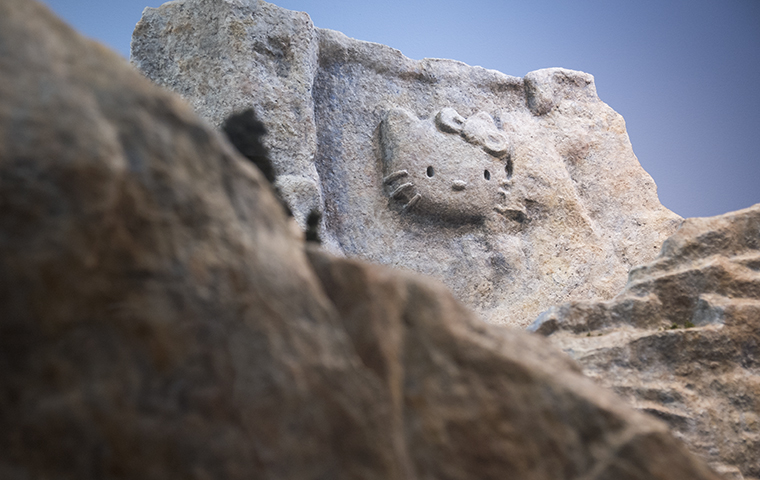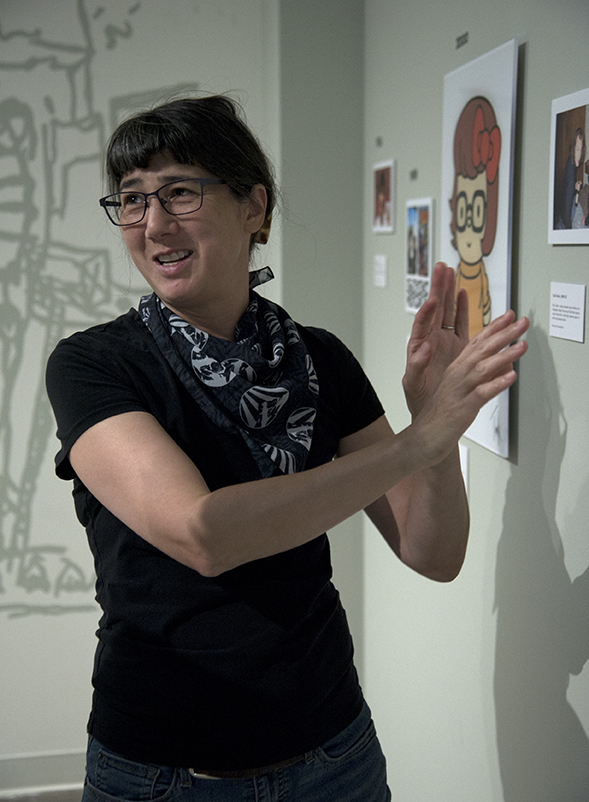
Here, Kitty
Kathy Aoki questions the Hello Kitty obsession with her immersive exhibit at the San Jose Institute of Contemporary Art.
To the uninitiated, Hello Kitty is a product of kawaii, the term for the culture of cuteness in Japan. She is, according to Sanrio, her creator company, not a cat, but a cartoon character who happens to look very much like one. Though originally marketed to young girls when she debuted in 1974, Sanrio has expanded Hello Kitty’s brand appeal beyond age or gender to teens and adults whose fondness for her has never faded.
But to others, like Kathy Aoki, associate professor of studio art at Santa Clara University, she has become a perfect example of society’s almost obsessive adherence to the tradition of cute.
Fascinated by an estimated $50 billion Hello Kitty cult, Aoki has explored this devotion to the character through exhibitions, most recently #WishYouWereHere, a fictitious visitor center she created for a Mount Rushmore-esque monument to Hello Kitty at the San Jose Institute of Contemporary Art.
Ethan Beberness ’19 recently stopped by the exhibit to talk with Aoki about her work. The following are edited highlights of that discussion.
So, what are your earliest memories of Hello Kitty?
Kathy Aoki: I’m old enough to remember when the brand was introduced to America in the mid-70s. I was a kid then, and I think Hello Kitty makes sense as a brand for children. But then in the ’90s, the Sanrio company rebranded their marketing and targeted adults for this re-up of Hello Kitty and all those characters. … So, that’s where most of the money comes from—adults buying it. It’s mostly adult women, and a lot of them are buying these products for themselves rather than for their kids. I liked Hello Kitty, and I remember in the ’90s when it came back, and finally I was like, “Wait a second, this is just taking my money.”

Kathy Aoki stands in her art exhibit on Hello Kitty
Walk me through this exhibit. What is the environment that you are aiming to create?
KA: The exhibition is painted to feel like a visitor center or nature center in a national park, and it has the timeline and stuff like that. So these two spaces are meant to be more immersive than, like, a typical art show where you go and you see something on the wall. I was trying to create more of a sense of place. The only break in that is the curator’s (audio) statement where she talks about what I’m really doing. But otherwise, there’s no clue that this doesn’t exist. People have come to the show and believed that it exists. They think it’s totally real. I had to break it to this whole family. They spent a long time in the show and, you know, did the augmented reality part and everything, and I usually don’t tell people, but I told them. And they were like, “What?!” So yeah, a lot of people believe it’s real.
At first glance, it seems like your exhibit is actually very pro-Hello Kitty, until you realize the satirical aspect of the work.
KA: I usually use humor as an entry point in my work as opposed to confrontational, angry messages because it’s easier for people to access that information. If you make angry work, then you’re immediately going to turn off a whole bunch of people. Part of the reason I use this format is because people are familiar with it. I’ve been to a visitor center. I’ve heard audio tours before, so they’re more receptive. I want them to be like, “What was that? Is this real?” And then, hopefully the question will be like, “Should it be real? Is this what we’re doing now?” I had to research to make sure this monument didn’t actually exist before I made this artwork because it could totally exist. Like can’t you imagine this existing?
So, like, what’s up with that? Why is that OK? I use a lot of museum [elements] to poke fun at or make satire, based on things that are actually valued in society. The perception of authority and “this needs to be preserved’’ that comes with museum centers like this is, again, just really over the top. Is it really important that in 200 years, we all visit, like, Gwen Stefani’s grave? (Editor’s Note: Gwen Stefani Grand Burial Exhibition, also by Aoki, focused on the deification of celebrities within pop culture and the media.) So that’s how I’ve been inserting humor into my work. And, you know, this is just fun creating the narrative.
Do you think you’ll get to the point where you’ll actually go up to a Hello Kitty fan and ask, “Why are you like this?”
KA: Well, I’ve asked people why and they’ve said… I don’t know. People get very angry about it. Like, as soon as I say, “It’s because Hello Kitty is too important,” they don’t want to talk to me anymore. I’m not ready to approach (someone) in the delicate manner that it would require. But, it’s weird. A lot of people come to this show and they’re Hello Kitty fans and they’re like selfie-ing it up and they’re like, “Dude, this is it. I’m in Hello Kitty Monument.”
#WishYouWereHere is on display at the San Jose Institute of Contemporary Art through September 9. For more information, call the ICA at (408) 283-8155.